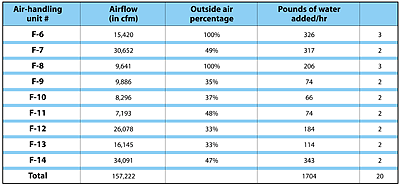
In recent years, many companies have humidified their offices as a means of cutting down on absenteeism. For hospitals, however, where infections can mean the difference between life and death for those in fragile health, it is even more critical to maintain humidity within the 30% to 50% range recommended by the CDC.
Great River Hospital (GRH) in Kitchener-Waterloo, Ontario is one facility that takes this matter to heart. With a staff of 2,350, it is the largest medical center in the Waterloo region, an urban area of 420,000 people, about an hour's drive southwest of Toronto. The hospital originally installed a sprayed coil humidification system in 1988 but replaced it with a steam system as part of an energy-saving program in 1990-91. In 1998, it switched to a high-pressure fog humidification system on nine of its air-handling units (AHUs). This improvement eliminated the health risk of additive chemicals in boiler feed water from the steam system entering the air stream, one of the drawbacks of the direct-steam method. However, rather than proving to be a costly improvement to offer patients cleaner air, high-pressure fogging turned out to be a cost-saving initiative.
"I worked on an energy balance which compared the running costs using boiler plant steam versus fog," said Bill Goodall, the recently retired director of facility redevelopment at GRH. "It showed a payback in less than one season based on the costs of steam production."
Fog Humidification System Specs
Before any fogging system is designed or installed, a water quality analysis is performed. "This is done both to eliminate clogging of the nozzles as well as ensuring high IAQ, free from dissolved solids and other waterborne materials," said Eric Adamson, director of hvac operations, at Mee Industries (Fort Mill, SC) the company that built and installed the fog system.At Great River Hospital, the water comes from a reverse osmosis (RO) unit manufactured by BioLab (Oakville, ON, Canada). The RO equipment sits in a water room adjacent to the mechanical room containing the AHUs and provides purified water for both the hospital's hemodialysis unit and the Mee fog system. This arrangement normally works well, but when the hemodialysis unit is operating at full capacity, it sometimes cuts down on the amount of water available for humidification.
The nine AHUs that were converted to fog share a common mechanical room. Although they vary widely in their airflow and humidification needs (Figure 1) a single pump is used to service all of them.
The system incorporates an FM-700-B1050 main pump unit with a 5-hp variable-frequency drive (vfd) motor to provide 1,000 psi to the fogging units in all the AHUs. The pump uses a three-piston design, rather than the typical two pistons, to avoid both pressure spikes and cavitation, ensuring a more constant pressure, reducing maintenance, and ensuring longer equipment life for both the pump and the other components in the system.
A vfd motor is used for two types of fogging humidification installations. The first occurs when the fog is being supplied to a single, large AHU with a high percentage of outside air. In such a case, the motor speed is changed to modulate the water pressure and the degree of humidification as needed. The other time a vfd is used is in a case such as at Great River Hospital, where there are a large number of fogging stages involved. "As these stages cut in and out, the pressure rises or falls," said Adamson. "The vfd senses this pressure change and speeds up or slows down the pump speed as needed to maintain the desired 1,000 psi."
Additionally, a recirculation hose is used to keep the pump head from overheating. This is not effective, however, when the pump is running at less than 25% of capacity, something that can easily happen since any one of the nine AHUs can activate the pump. To circumvent this problem at GRH, the recirculation hose is run to the RO storage tank. In those installations where there is no tank, a pump cooler must be installed in the recirculation loop.
The pump sends the water into a main feed line that supplies all the units. Within the cross section of the inlet for each AHU are two or three individually controllable nozzle arrays providing an ultra- fine mist (approximately 10-micron droplet size) for rapid evaporation. A droplet filter is placed downstream of the nozzles to catch any unevaporated droplets. The excess water is carried away through the drain pan.
At GRH, nozzles are pointed against the direction of the airflow, which is normal in fog humidification installations. As the hospital installation only allowed 36 in. between the nozzle array and the existing preheat and cooling coils, it experienced more water loss than in a typical installation.
"The project was designed knowing the 36-in. distance limitation," said Great River's Goodall. "This meant that we had to also improve our drains and seal the floor surfaces to prevent any water problems."
Moisture on Demand
Rather than using a programmable logic controller (PLC) to run GRH's humidification system, it was instead tied directly into the hospital's existing energy management control system (EMCS). The hospital had purchased the EMCS, by Delta Controls (Surrey, BC, Canada), as part of a $7.7 million energy upgrade project done by Rose Technology Group (Toronto, now a part of VESTAR, Inc.)
Sensors were installed to measure the humidity in each zone of GRH being serviced as well as the humidity of the air returning to the AHU. In addition, the ducts contain high-limit sensors to prevent wetting of the ducts and the mold problems this causes. "When one of the sensors in any of the service zones detects a humidity level below setpoint, it turns on the fogging system pump unit and activates one or more solenoids controlling the valves to the fogging nozzles for the appropriate AHU," said Adamson. "As additional zones need humidification, the valves for the appropriate nozzles are opened, and the vfd motor speeds up to maintain the pressure."
Plus and Minus
Once installed, the hospital did experience some initial problems. Since there was only a 36-in. spray distance due to space constraints, the droplet filters caught more water than usual. Normally this would not be a problem, other than increasing the amount of wastewater. But at GRH, old, rusted drain pans coupled with cracks in the cement floor, caused water damage to the floor below. The hospital solved the problem by upgrading the drains and sealing the floors.Beyond that, however, the system has delivered on the expected cost savings. A fogging system uses 1.5 hp to atomize 1,000 lb of water. This is about 3% of the electrical energy that a compressed air or ultrasonic water atomizer uses, and 1% of the amount required by a steam humidification system.
In addition, the evaporation from a high-pressure fogging system lowers air temperature. In a building where there isn't a high heat load, the customer will have to raise the temperature of the preheat or heating system to compensate for the cooling effect of the evaporation. The enduser must consider this additional cost as one of the factors in selecting the best type of humidification for a particular installation. In most instances, however, the low energy cost of the fogging system more than offsets any additional heating cost.
In buildings where there is a high heat load, however, the cooling is an added benefit, that can reduce the need for using a chiller, a savings that can pay for the fog system in a few months to a year. At GRH, the fog system is used from November until April, depending on the rh and when cold weather sets in. According to Goodall, personnel at GRH were "happy that the evaporative cooling effect during spring and fall periods saved a lot of chiller consumption, especially in the spring when the 4 to 5 degrees of cooling allowed the delay of starting the chiller plant with its electrical demand penalty."
Even when additional heating is required to offset the evaporative cooling at GRH, it is not considered a significant problem. As part of the energy upgrade that the hospital went through 10 years ago, condensing towers were installed to reclaim boiler flue gas heat. That heat is used to produce low-grade hot water that circulates through the chilled water coils during the heating season. According to Adamson, the evaporative cooling load is accommodated using reclaimed heat.
The true test of any system, however, is not what the customer has to say about it, but whether the customer would do it all again. The hospital has $157 million worth of capital improvement projects underway, including a new $48 million regional cancer center and a $10 million upgrade to the emergency room/MRI facilities. "It should be noted," says Goodall, that GRH expansion plans include similar humidification systems "in both replacement of the existing nine AHUs as well as new units in the new cancer treatment building and new ER facility." ES


